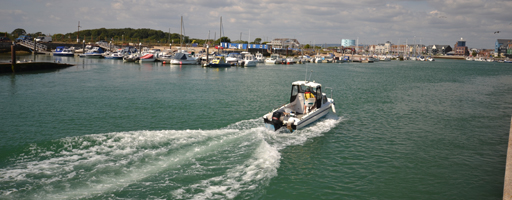Littlehampton, Unexpected Delights
20 Aug, 2015

Littlehampton may not be everyone’s idea of an historic town, but in actual fact it has more surviving Regency and Georgian buildings than its far bigger neighbour, Worthing. Whereas, Worthing demolished the heart of its old town between 1950 and 1970, most of the seaside buildings put up in Littlehampton at the end of the eighteenth and the beginning of the nineteenth centuries still stand.
The eastern end of South Terrace is one of the best examples of Regency seaside architecture to be found anywhere on the south coast outside of Brighton. Originally this up-market development was quite separate from the old village of Littlehampton, then located a kilometre to the west, and purposefully so - 'select and genteel company' did not wish to be up, close and personal with the poor benighted folk who lived in miserable hovels along the western approaches of what is today the High Street.
Sea bathing and the so-called 'sea cure' were very popular amongst the wealthy over two hundred years ago and those coming to Littlehampton sought their amusements at the recently built Beach Hotel which once stood on Beach Green. There was also the New Inn in Norfolk Street, where coaches would stop to allow visitors to the new resort to disembark.
In 1829, Thomas Henty of Church House, Tarring - one of the county’s leading landowners - held a farewell part at the New Inn before he set sail with his family and two flocks of Marino sheep to start a new life in Australia.
The Dukes of Norfolk were a powerful influence in Littlehampton for several generations and owned most of the land and, therefore, most of the houses. Only in the 1930s, suffering from the effects of the economic down turn and accumulated death duties, did the then Duke decide to sell his Littlehampton estate. It was at this time that the charming assemblage of coastguard cottages, a windmill and a 'pepper pot' lighthouse that stood on the eastern side of the harbour mouth, were demolished.
The old oyster pond at the southern end of River Road was retained and converted into an ornamental lake for toy boats and proved very popular with sons and fathers in the summer months. At one time vast numbers of oysters were fished of Littlehampton and kept in the oyster pond until a buyer could be found. In fact the fishery was too successful and the oysters were over-fished so that stocks collapsed and it was no longer possible to make a living from the trade. The popular Oyster Catcher pub recalls this time.
The Southern end of River Road still contains a terrace of cottages called 'Mussel Row,' whether the name is a reference to the shellfish fisherman who lived here or to their brawny and muscle-bound stature, is a matter of conjecture. Today these cottages are now shops, typically selling ice cream and fish and chips.
Beyond River Road is Surrey Street, where two of the town’s oldest pubs can be found - the White Hart and the Dolphin. In the 1860s, Littlehampton’s riotous bonfire boys celebrated November 5th outside the old coaching inn, by hauling old boats from the harbour and setting them on fire in the street to the consternation of local residents.
The Dolphin has been rebuilt, but it has an interesting history. Lord Byron was once stayed here.
The old Manor House still survives in Littlehampton and is today in use as the offices of Littlehampton Town Council. It also houses the excellent Littlehampton Museum. Next door is the parish church which has been twice rebuilt - in the 1820s and the 1830s. The current building looks rather like a small version of Guildford Cathedral, having being built at about the same time.
Littlehampton has seen considerable regeneration in recent years making it a popular destination for tourists, the sailing fraternity as well as home owners and families.
With thanks to local historian and author Chris Hare for this article.
As you have just read, Littlehampton is home to some wonderful historic property, has excellent transport links and a bustling sailing community. The town’s property still offers fantastic value for money. Thinking about moving there? Contact Jamie Bryant in our Goring office for the all the info you’ll need. 01903 331567.